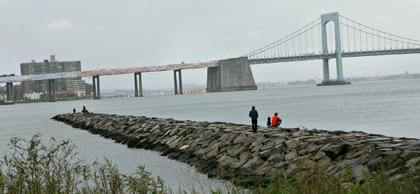By Connor Adams Sheets
A College Point scientist has found high levels of toxic lead and Tributyl tin below the Throgs Neck Bridge between Crider Point in northeast Whitestone’s Throgs Neck Bridge Park and Fort Totten in Bayside.
Dr. James Cervino, a marine biologist at Woods Hole Oceanographic Institute, said the heavy metals collected there as a result of work by the Metropolitan Transportation Authority to remove lead-based paint from the 2,300-foot bridge.
The levels of metals found fall within federal and state guidelines for soil under or in residential developments, according to a study whose results Cervino released last week, but are still too high to protect plants, animals and humans, as contaminated paint chip debris was found throughout the park.
“If something’s being scraped, blasted or removed with paint thinner, you can’t leave any of that where kids are going to play,” he said. “Zero concentrations of lead and Tributyl tin contained in paint chips or particles being remediated off of a construction project, building or bridge are allowed to rain down on walkways, ball fields and wetlands.”
Lead and tributyl tin are carcinogens that can have negative effects on the function of human nervous, cardiovascular, neurological, renal and other systems. Low levels of lead can build up in the body over time, slowly affecting the body as it hits dangerous levels.
The effects of lead are particularly acute in infants and children, so Cervino said it is critical to keep it out of parks and other areas where children gather.
MTA Bridge and Tunnels spokeswoman Judie Glave said the agency had not yet seen the report, but the ranges of heavy metals found were all within the federally defined acceptable range for soil levels. Glave said in December that measures to ensure containment of such toxins had already cost the agency $1 million in the course of the $96 million rehabilitation project.
“MTA Bridges and Tunnels stringently follows all state and federal environmental regulations when it comes to lead paint removal,” Glave said. “We’ve dedicated significant resources to environmental testing throughout the paint removal project at the Throgs Neck Bridge, and all of the readings taken during the testing were within the acceptable range.”
But state Sen. Frank Padavan (R-Bellerose) said the levels of heavy metals Cervino collected and analyzed with the help of Paul Bergin, a junior at St. Francis Prep High School in Fresh Meadows, are a health hazard to children and others who use the park and surrounding areas.
“The analysis conducted by environmental scientist Dr. James Cervino clearly and unequivocally uncovered significant lead paint contamination in the soil samples, which poses serious health risks,” Padavan wrote in a March 1 letter to Susan Kupferman, president of MTA Bridge and Tunnels. “The data clearly demonstrates that quick action must be taken to resolve this situation. As a result of these findings, I have begun the process of demanding that the Metropolitan Transportation Authority … remediate the area.”
A number of residents of northeast Whitestone communities have complained about dust and debris from the Throgs Neck construction project.
Randy Schwartz, who lives in the Le Havre community, located near the bridge, said she believes the MTA should do all it can to protect area residents.
“I think it’s horrendous, being exposed to toxic metals,” she said. “I don’t know what’s in that paint.”
Reach reporter Connor Adams Sheets by e-mail at csheets@cnglocal.com or by phone at 718-260-4538.






























